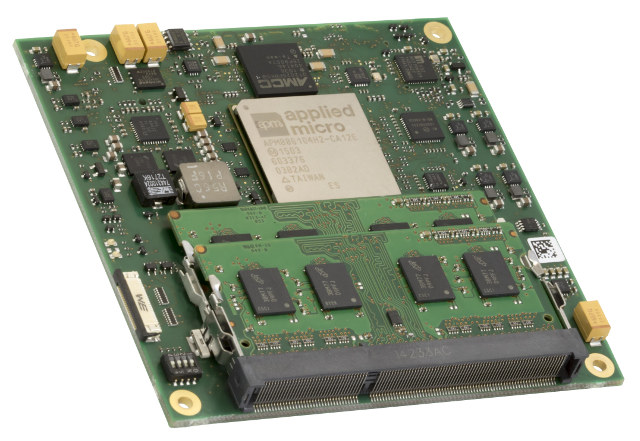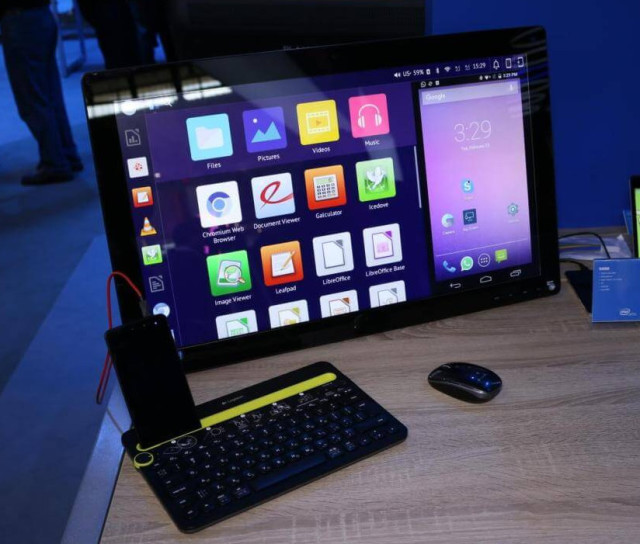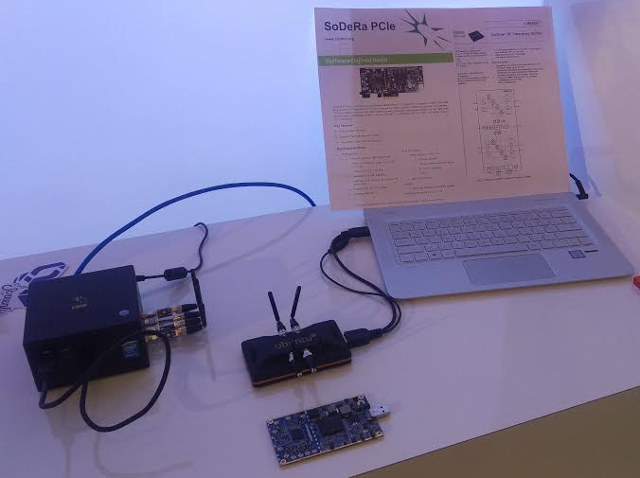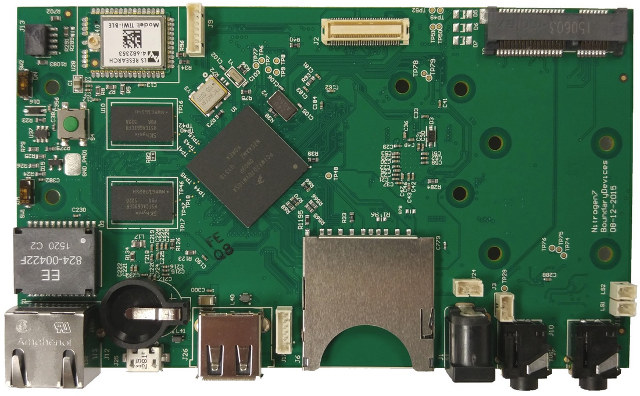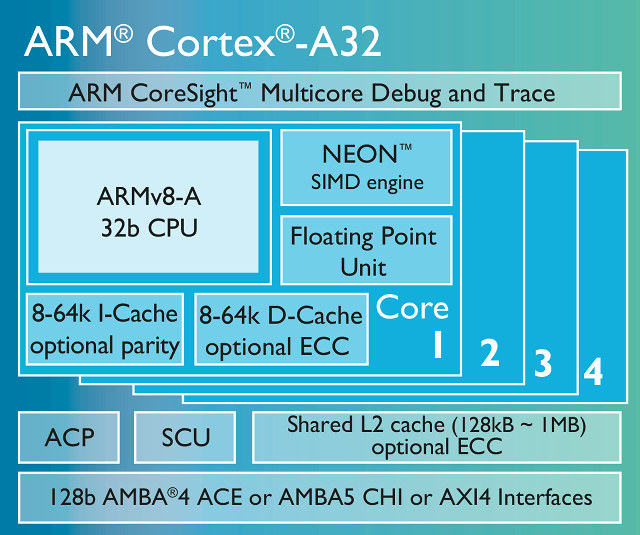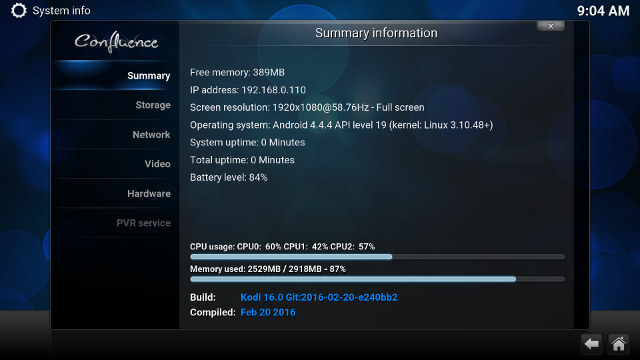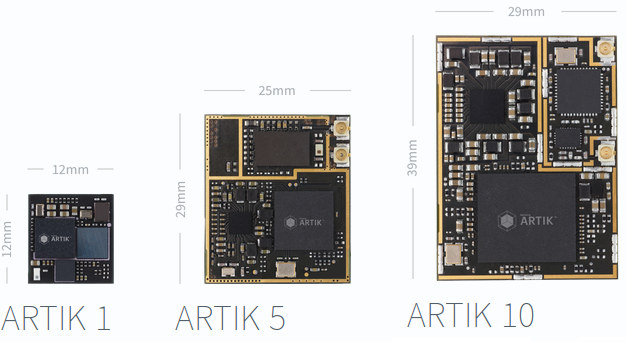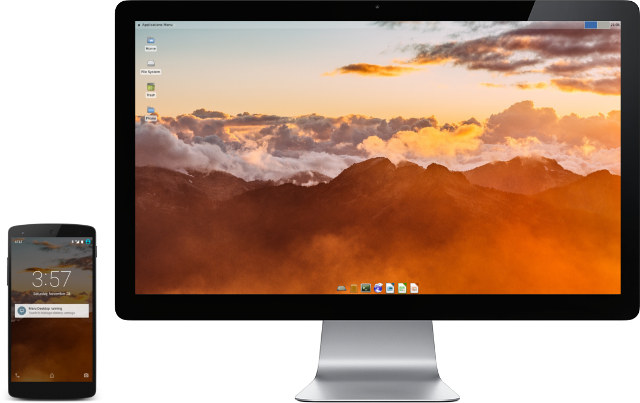Theobroma Systems has introduced a new COM Express module, named HeliX2-COMExpress, powered by Applied Micro HeliX 2 ARMv8 server SoC and probing 10GBe, SATA, and PCIe connectivity, as well as SO-DIMM slots for up to 32GB RAM for embedded industrial applications. HeliX2-COMExpress specifications: Processor – Applied Micro APM887104-H2 “HeliX 2” with 2 to 4 ARMv8 cores up to 2.0GHz, 32KB L1 I-cache and 32KB L1 D-Cache (per core) with parity-protection, shared 256KB L2 cache (per pair of cores) with ECC protection, and 2MB L3 cache with ECC protection System Memory – 2x 204-pin SO-DIMM slot for up to 32GB DDR3 @ 1600MHz Storage – Serial ATA SATA Gen 3 (integrated), up to 16MBit SPI NOR flash on-module, up to 128GB eMMC flash on-module Connectivity 1x 10 Gigabit-Ethernet (XAUI) 1x 1000Base-T with on-module 10/100/1000 PHY 1x RGMII Gigabit Ethernet 2x SGMII Gigabit Ethernet USB – 3x USB 2.0 (one dual-role […]
Intel Showcases Mobile & Desktop “Convergence” with Android and Debian Linux on an Atom x3 Smartphone
MaruOS is an operating system combining Android and Debian Linux that – until recently – was developed by a single developer for Qualcomm Snapdragon 800 (ARM) based Nexus 5 smartphones, and use Android on the go, while switching to Debian when the phone is connected to a larger display and a keyboard and mouse. It turns out Intel had the same idea, and they worked on an Intel Atom x5 smartphone with 2GB RAM running both Android Lollipop in mobile mode, and Debian Linux as desktop mode when connected to a keyboard dock. Intel does not talk about convergence, but instead calls it “Big Screen Experience”. Based on the picture above taken by WinFutures.de at Mobile World Congress 2016, it appears you can also display both Debian and Android operating systems side-by-side if you wish to. They’ve also shot a video (in German) showing the smartphone run Android, and after […]
Canonical Introduces SoDeRa Software Defined Radio Solution for Base Stations and IoT Gateways
Canonical and Lime Micro have jointly announced SoDeRa low-cost software defined radio (SDR) which can be programmed to support any type of wireless standard including UMTS, LTE, LoRa, Bluetooth, Zigbee, RFID, Digital Broadcasting, and more, and aiming at helping operators reducing costs & complexity, while speeding up time to market and providing greater flexibility. The kit will include a board with the following specifications: FPGA – Altera Cyclone IV EP4CE40F23 Altera FPGA (compatible with EP4CE30F23) System Memory – 256 MB DDR2 SDRAM RF Lime Microsystems LMS7002M Transceiver with continuous Frequency range of 100 kHz – 3.8 GHz 4 x TxOut and 6 x RxIn U.FL connectors for RF cables Power Output (CW): up to 6.5 dBm Wi-Fi, 2G, 3G, LTE, any other air interfaces USB – 1x micro USB3 via CYUSB3014-BZXC Cypress Microcontroller for control, data transfer and power Misc – Status LEDs, RGB LEDs, 4x switches Dimensions – 100 mm x […]
Boundary Devices Nitrogen7 Single Board Computer is Powered by NXP i.MX7 Processor
While several system-on-modules based on Freescale/NXP i.MX7 processor have been announced such as Compulab CL-SOM-iMX7, or TechNexion PICO-IMX7-EMMC, I had not seen many single board computers or development boards based on the new processor, apart from Freescale i.MX7 96Boards by Arrow Electronics which was scheduled for Q4 2015, but has yet to launch. Boundary Devices Nitrogen7 board is another option that’s available now (in limited quantities) with NXP i.MX7 Cortex A7+Cortex M4 processor, 1GB RAM, 4 to 64GB eMMC, wired and wireless connectivity, and expansion headers. Nitrogen7 board specifications: SoC – Freescale i.MX7 single or dual ARM Cortex-A7 processor @ up to 1GHz + ARM Cortex-M4 MCU + 2D graphics engine System Memory – 1GB DDR3L Storage – 4GB eMMC flash (expandable to 64GB), 2MB Serial NOR Flash, SD card slot Connectivity – 1x 10/100/1Gb Ethernet, WiFi 802.11 a/b/g/n, Bluetooth 4.1 (TiWi-BLE combo module) Display – 24-bit RGB (via expansion […]
ARM Unveils Ultra-efficient Cortex-A32 32-bit Processor Based on ARMv8 Architecture
So far you could safely equate 64-bit ARM processors with ARMv8 architecture. Not anymore. A few months after introducing Cortex A35 low power ARMv8 64-bit processor, ARM has now announced Cortex-A32 processor, even more power efficient, support ARMv8-A architecture, and designed for 32-bit embedded and IoT applications. Key features of Cortex-A32 cores: Architecture – ARMv8-A (AArch32) Multicore – 1-4x SMP within a single processor cluster, and multiple coherent SMP processor clusters through ARM AMBA 4 ACE, AXI 4 or AMBA 5 CHI technology ISA Support A32+T32 with full backward compatibility with ARMv7-A ARM TrustZone security technology ARM NEON Advanced SIMD DSP & SIMD extensions VFPv4 Floating point Hardware virtualization support Debug & Trace – ARM CoreSight DK-A32 So they’ve got rid of AArch64 instruction set out of ARMv8 architecture in order to improve power efficiency, while keeping the 100 new instructions part of Aarch32 to improve performance, and keeping ARMv7-A […]
Kodi 16 “Jarvis” Release
This morning, I saw Kodi installed from Google Play get an update in one of my Android device, and that means that Kodi 16.0 “Jarvis” has now been released. As usual it’s available for Windows, Linux, Mac OS, Android, and iOS, with specific Linux ports for Raspberry Pi boards, and several Freescale/NXP i.MX6 boards such as Wandboard or EzeeCube. You can get the full Changelog in the Wiki, but some of the main changes against Kodi 15 include: Various new features for Live TV and PVR (Personal Video Recorder) Added RDS Radio, FM radio, scheduling recordings of TV shows… Various improvements such as speeding up EPG database access. Added, updated, and improved PVR backend clients addons for all popular third-party external PVR backend platforms: FilmOn, HDHomeRun, Enigma 2, Tvheadend HTSP Client, and so on. Add-ons Framework, API, and Manager improvements Platform Independent Playback improvements : software DTS-HD decode with libdcadec, […]
Samsung Artik IoT Boards and Devkits with WiFi, Bluetooth LE, and Zigbee Available, Partners Announced
Samsung Artik IoT boards will finally start selling on February 22 via Digikey. With the many fascinating developments in the IoT space over the year, you’d be forgiven if you completely forgot about Samsung Artik boards. So let’s have a quick recap. The Korean company previously announced three boards all supporting Bluetooth LE: Artik 1 – Ineda Systems Dual Core microAptiv MIPS32 processor with 1MB on-chip RAM, no GPU, and 4MB SPI flash Artik 5 – Dual core Exynos ARM processor @ 1GHz with ARM Mali 400 MP2 GPU, 512MB RAM and 4GB eMMC flash (both on-chip), with WiFi & Zigbee/Thread connectivity Artik 10 – Octa core Exynos processor with 4x ARM Cortex A15 @ 1.3GHz, 4x ARM Cortex A7 @ 1.0 GHz with ARM Mali-T628 GPU, 2GB LPDDR3 (on-chip), 16GB eMMC flash, and WiFi & Zigbee/Thread connectivity Samsung also partnered with multiple companies working on: Operating Systems – Tizen, […]
Open Source Operating Systems News – Maru OS, Zephyr, ReactOS, Tizen 3.0, and Raspbian
There have been several news related to open source operating systems in the last couple of weeks including Maru OS to run Debian on Android, Zephyr Project real-time OS managed by the Linux Foundation, ReactOS an open source port of Windows XP, and Raspberry Pi boards are getting a Tizen 3.0 port, as well as a new Raspbian release. Maru OS – Mobile <-> Desktop Convergence Maru OS mobile operating system is supposed to do what Ubuntu convergence promised: it runs in mobile mode on the go with Android Lollipop mobile OS, once you connect the phone to an HDMI screen, and pair Bluetooth keyboard and/or mouse, it will switch to desktop mode running Debian Linux. The downside is that so far it a single developer (Preetam D’Souza) worked on it, and the beta version only works on Nexus 5 smartphone. However, since the project went viral, dozen of other […]


